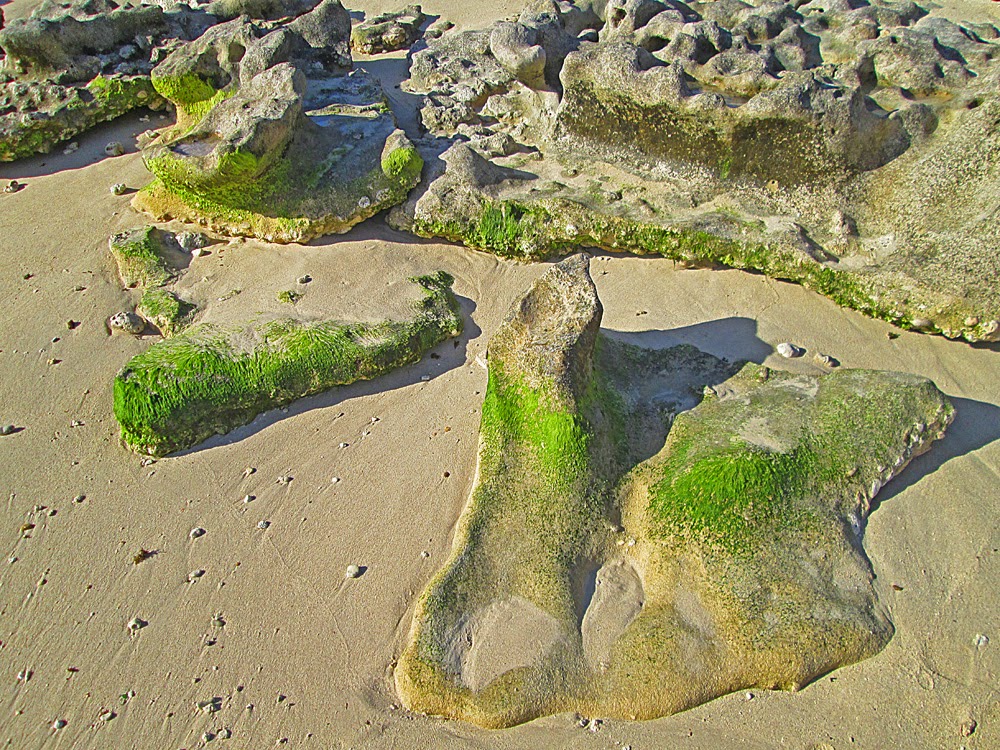Honouliuli Ewa Limu Was the "House Of Limu" Because Of Ewa Plain Karst Spring Water
By John Bond, Kanehili Cultural Hui
Where healthy edible limu (algae) is found is nearly always where fresh water
enters into the sea, providing the necessary nutrients for regeneration.
Shutting off or polluting this karst water system kills off the entire marine
ecosystem- from small reef fish all the way up to large pelagic fish.
Coral reefs were important to the ancient Hawaiians for subsistence, culture, and survival.
According to the Hawaiian Creation Chant, the kumulipo, the coral polyp was the first creature to emerge from the sea during creation. The early Hawaiians recognized that coral reefs were an essential building block of their existence and used coral in religious ceremonies to honor and care for ocean resources.
According to the Hawaiian Creation Chant, the kumulipo, the coral polyp was the first creature to emerge from the sea during creation. The early Hawaiians recognized that coral reefs were an essential building block of their existence and used coral in religious ceremonies to honor and care for ocean resources.
Ancient Hawaiians saw that from the ancient karst sprung thousands of freshwater springs, fostered an entire bountiful marine ecosystem, aerated fishponds and provided lush agricultural kalo fields.
HART's construction operation always claims they never hit karst or any caves or water channels yet this can clearly be shown as false.
*************************************************
enters into the sea, providing the necessary nutrients for regeneration.
Shutting off or polluting this karst water system kills off the entire marine
ecosystem- from small reef fish all the way up to large pelagic fish.
West Oahu Eco-Disaster: HART Rail Hitting Karst Water, Sea Caves And Polluting Ewa-Honoululi-Waipahu Wetlands
West Oahu's greatest natural apocalypse is unfolding, with hundreds
of 8 foot in diameter, 200 foot deep drill bores, the ancient karst water, sea caves and
wetlands are being fractured and polluted, then to be followed by
a major new asphalt and concrete city based around
three huge HART Rail Transit Oriented Developments.
The already fragile Ewa Plain ecosystem based on natural clean water will be destroyed.
of 8 foot in diameter, 200 foot deep drill bores, the ancient karst water, sea caves and
wetlands are being fractured and polluted, then to be followed by
a major new asphalt and concrete city based around
three huge HART Rail Transit Oriented Developments.
The already fragile Ewa Plain ecosystem based on natural clean water will be destroyed.
Fresh spring water is especially important in the propagation of plant and sea life and the food chains they create- from limu on up to large pelagic fish.
Surface and ground waters are very susceptible to contamination from pollutants.
Contaminants can reach ground water quickly through fractured rock formations or sinkholes in karst areas, such as that found in Ewa. Ground water is more sensitive to contamination in these areas because runoff may pass directly into the subsurface with little if any infiltration through the soil, a process that typically filters at least some pollutants.
The eight foot in diameter Waipahu deep boring rail column sites have been a consistent
problem for Kiewit because they are hitting large amounts of underground water channels.
The entire ancient history and plantation era history is loaded with springs popping out of the ground everywhere. For agriculture and fish ponds these were ideal conditions. Today everything is being covered in concrete and asphalt with deep boring shafts and concrete down as deep as 200 feet.
Deep karst waterway channels flow underground through the entire Ewa Plain route
and sites of three transit oriented development rail stations.
Mike Lee: Mountain water and rain fall streams flow directly through the Ewa Plain ancient
coral reef and into the shore and reef system, affecting the health and pollution of these traditional native Hawaiian resources which are also the basis for Oahu's marine ecosystem.
Limu gathering is a traditional cultural practice and the area where Mr. Lee gathers limu at Onelua is potentially eligible as a TCP. ...
geotechnical borings have indicated The East Kapolei station
approach penetrates into the coralline deposits.
and sites of three transit oriented development rail stations.
coral reef and into the shore and reef system, affecting the health and pollution of these traditional native Hawaiian resources which are also the basis for Oahu's marine ecosystem.
Limu gathering is a traditional cultural practice and the area where Mr. Lee gathers limu at Onelua is potentially eligible as a TCP. ...
geotechnical borings have indicated The East Kapolei station
approach penetrates into the coralline deposits.








No comments:
New comments are not allowed.